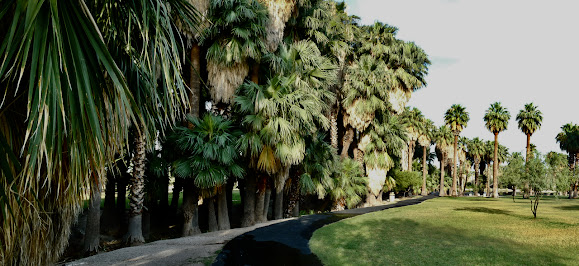I recently wrote a blog about Agua Caliente Park, which we visit almost every morning. In my blog I tried to list the reasons we are so loyal to it. First of all, we can hop in our car and be there in eight minutes. It's an oasis in the midst of the desert, with lakes and aquatic vegetation suddenly creating a very different, and refreshing landscape, especially because of the many ancient and enormous palm trees. My legs are getting older and I need a good walk to keep them working, and a walk around the outer ring of lakes is perfect for them. And, of course, I mentioned in my earlier blog, we don't know many people here, so our daily social life consists of the people we meet at the park (who come for their own exercise and to walk their dogs).
So we were somewhat at a loss when we heard the park was closed for a full month to give them some time to clean up the damage they had from a lightning strike. But actually we already had a substitute, one we took when we wanted an occasional variation. We drive straight up the Mt. Lemmon Road till we get to Gordon Hirabayashi Park.
That takes a bit longer to get to, but otherwise has similar features. A road goes straight through the center, following a creek, and the sides are often rich with wild flowers. You park shortly after you enter the park, and if you then walk to the end of that central road and walk back again to where you parked, it is just right for our walk.
But do you know what? We have learned something. What we love so much here is the wildlife. These parks are kept to be attractive to wildlife, and no doubt it is there, and you can occasionally glimpse a bobcat or coyote or deer, but I think they are disturbed by the press of people and stay concealed until dark.
But here at home is where we see it. We have about a third of an acre, a mixture of trees, cacti and open areas, and the other houses here on the edge of town often also continue the unbroken natural desert for the animals to slip on through. Many washes come down from the mountains providing corridors for the animals to travel along. We put out food for birds, and that brings them up close to the house where we can see and photo them. It is against the law to put out food for the mammals, the creatures we are most interested in, but that is not a problem. This is a desert and what everything wants is water, and we put out a bird bath outside the front window and have several big dishes of water scattered around the backyard.
Often the animals walk right up to our windows. The other day a large handsome bobcat came up to a water dish we had in our backyard and spent a long and careless time drinking his fill.
Not long before this I looked up from a book I was reading and looked out the front window by our bird bath and three enormous Mule Deer were looking in at us. They looked as tall as horses and each one probably weighed 250 pounds. They show up in our yard every year, only bucks, and usually with their antlers still in velvet. But pretty soon they will start knocking off the velvet and fighting each other
and looking for females. Like the males the females will break off into only female groups, but they will still have their last years' fawns with them, and I think stay farther up the mountain, so we never see them in our yard.
When we least expect them, suddenly one or more coyotes come strutting up the yard, and it is fun to see their quickness, always looking like they have a plan, in a flank, for instance, twenty feet apart from each other, hoping to surprise a small rabbit that will veer off from one coyote to run right into another. Before you know it the coyotes have come the distance of our back yard and are now crossing the road in front of our house, and are gone.
Here is one trying to dig out a ground squirrel it can hear under the surface.
And though we have the javelinas, our notorious pig-like peccaries, fenced out of our yard because they do so much damage (knocking down our garbage can and scattering the garbage all over is the least of it) they occasionally dig their way into the back yard, usually a gang eight or ten with all their babies with them, and they are such characters we enjoy seeing them anyway.
What I'm getting at is, we love all of the wilds of Tucson, but it is only in our own backyard that we can regularly count on something amazing making an appearance. So maybe we need to sit on our porch and stop complaining.
walk











.jpg)

.jpg)











.jpg)

.jpg)












.jpg)
.jpg)




.jpg)

.jpg)
